Mongolian/Inner Mongolian vocab differences
2 March 2012 (Slight additions and corrections on 24 March 2020)
I once had occasion to pick up some Mongolian vocabulary cards in Hohhot. After figuring out what the incredibly attractive but hard-to-understand letters meant, I noticed that while much vocabulary is the same in the two standard varieties of Mongolian (Chahar in Inner Mongolia, Khalkha in Mongolia), there are some obvious differences. Some are due to Chinese influence in Inner Mongolia, no doubt confirming the darkest suspicions of the Mongolians about their co-ethnics across the border. But there are also traditional dialect differences, and also later developments where the Inner Mongolians have sometimes developed better vocabulary than Mongolia itself.
The following are a just a few examples of differences that I noticed.
First, a vocabulary item that shows very obvious Chinese influence:
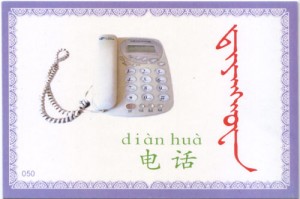
Given the aversion of Mongolians of Mongolia to pure Chinese vocabulary, this is the sort of word that is least likely to find its way into Cyrillic letters, but I’ll take a stab at it and transliterate it as диенхуа dieŋhua. This is from the Chinese word diànhuà (电话/電話) ‘telephone’ — although the word diànhuà itself was probably coined by the Japanese as denwa (電話). The Mongolian word for a telephone is утас utas ‘wire’, apparently abbreviated from телефон утас telefon utas ‘telephone wire’. Телефон telefoŋ, from Russian, is also sometimes used.
Although Inner Mongolian borrows its word for ‘phone’ from Chinese, surprisingly the word for mobile phone or cellphone is the same as in Mongolia, namely гар утас gar utas ‘hand phone’:
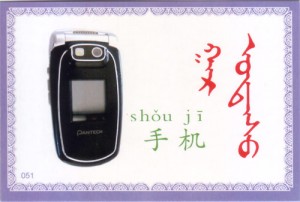
Other examples of Chinese influence are more subtle. The word for ‘bus’:
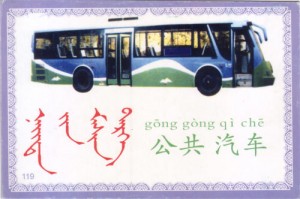
This is given as нийтийн машин тэрэг niitiŋ mashiŋ tereg ‘public automobile’. This is a direct translation from Chinese gōnggòng qìchē (公共汽车/公共汽車) ‘public automobile’ = ‘bus’. Incidentally, машин тэрэг mashiŋ tereg is a collocation less often found in Mongolia, where машин mashiŋ by itself is normally used for ‘car’, ‘truck’ etc.
The Mongolians call a ‘bus’ автобус avtobus, again from Russian, although in normal conversation it has come to be pronounced more like автус avtus. (As a further twist, the Chinese model for the Inner Mongolian name is now becoming old-fashioned in Chinese, where gōngjiāo-chē (公交车/公交車) ‘public transport car’ seems to be becoming the favoured form.)
While it may seem that the Inner Mongolians are heavily influenced by Chinese, there is plenty of vocabulary where they use non-Chinese international vocabulary. For example, the computer:
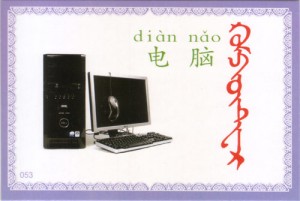
That very involved set of letters on the right actually spells out компьютер kompyuter, which is the word for ‘computer’ in both Mongolias. (Notice that the Chinese on the card uses the Taiwanese import diànnǎo (电脑/電腦) ‘electric brain’ in preference to the recommended Mainland term jìsuàn-jī (计算机/計算機) ‘calculating machine’.)
In other cases the difference is due not to Russian or Chinese influence but to dialect differences in Mongolian itself. My favourite is the word for ‘apple’:
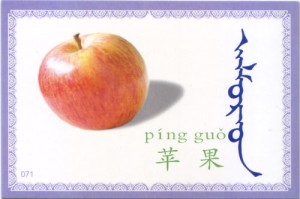
The word shown here is алмарад almarad, although this may be slightly bookish. According to dictionaries, in everyday life пингуо pinguo, from Chinese píngguǒ (苹果/蘋果), is often used. As a name for the apple, алмарад almarad is quite old. It appears in a mid-Qing dictionary as the Mongolian word corresponding to 蘋果 píngguǒ. It is related to Turkic words for the pear (cf Kazakh алмұрт almurt, Turkish armut).
The Mongolians of Mongolia and the Buryats, too, call this fruit алим alim, which is probably also a very old borrowing from the Turkic languages (cf Kazakh алма alma, Turkish elma, etc meaning ‘apple’). In Inner Mongolia, on the other hand, алим alim means something completely different:
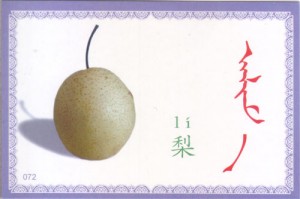
Yes, that is a pear that you see. Somewhere along the line apples and pears appear to have got reversed in Inner Mongolia.
In Mongolia itself, the pear is called лийр liir, which is ironic because лийр liir is clearly a borrowing from Chinese, maybe from lír (梨儿/梨兒) . In Mandarin it is now normally called lízi (梨子). This is a case where the Inner Mongolians are less sinified than the Mongolians!
While we’re on fruit, the word for banana is the international банан banaŋ in both Inner Mongolia and Mongolia:
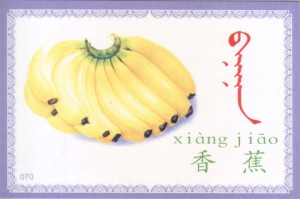
Another name for this is the preferred (although not necessarily most popular) term гадил gadil, for which I don’t have an etymology. And the Inner Mongolians also apparently use the Chinese word xiāngjiāo (香蕉) ‘banana’, pronounced сянжао syaŋjao. The fact that fruit has different names isn’t surprising. It is one area where many languages — Spanish is notorious for this, but English is certainly not immune — appear to have different local names.
Finally, a case where the Mongolian word is demonstrably inferior to the Inner Mongolian:
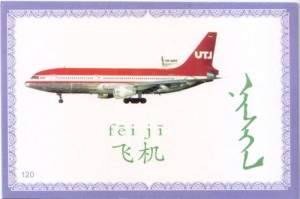
The Inner Mongolian name for a plane is нисгэл nisgel, from нисэх nisekh ‘to fly’. The Mongolian name is онгоц ongots. The problem with онгоц oŋgots is that it also refers to one of these:
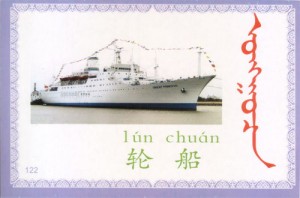
That’s right, the word онгоц oŋgots is the Mongolian word for a boat or ship. If by some not so far-fetched conjunction of circumstances they need to distinguish the two, Mongolians have a choice of using усан онгоц usaŋ oŋgots ‘water boat’ for a boat or хөлөг онгоц khölög oŋgots ‘ship boat’ for a ship. A plane can be (but is usually not) distinguished as нисэх онгоц niseh oŋgots ‘flying boat’.
By using нисгэл nisgel as a separate, sensible and quite transparent word for ‘aeroplane / airplane’, the Inner Mongolians have avoided this kind of confusion.
As a final twist, the different words for aeroplane and ship give rise to totally different words for ‘aircraft carrier’ in Mongolia and China.
In Mongolia, aircraft carriers are known as онгоц тээгч хөлөг oŋgots teegch hölög, ‘plane-carrying ship’. In China, they are called нисгэлийн суурийн онгоц nisgeliiŋ suuriiŋ oŋgots ‘plane base ship’.
To sum up:
The Inner Mongolians use more Chinese loanwords, but that doesn’t mean the Mongolians (despite their self-image) don’t use them.
The Mongolians use a lot of Russian words (many more than is apparent from the above examples), but that doesn’t mean the Inner Mongolians don’t use them.
Mongolian vocabulary solutions aren’t necessarily superior to Inner Mongolian ones.
